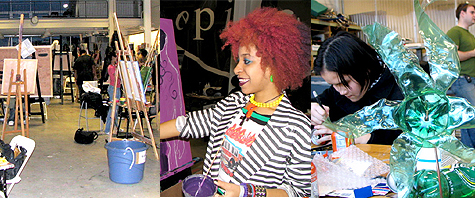
Unlimited potential: An interview with Susan Rodgerson,
Founding Director of Artists for Humanity
In the soaring, light-drenched office of Artists for Humanity, staff members work in a large common room. Youth traipse through, greeting everyone on their way to the photography, sculpture, and silkscreen studios on the same floor. WKCD writer Abe Louise Young met with Susan Rodgerson to discuss her philosophies and the evolution of the fifteen-year-old arts-and-enterprise program for urban youth.
WKCD: So, what happened fifteen years ago to start this project?
RODGERSON: I became friends with some students at a middle school I
visited, and the kids began waiting for me at my studio. They wanted
to stay all day, and I was driving them home at night. What began to
happen was, the kids started relaxing. We were painting together, and
creativity took over. We didn't want to separate. Four of those five
original kids are still involved with Artists for Humanity today.
WKCD: What else was happening during that time?
RODGERSON: In 1991, Boston was only second to Los Angeles, in terms of
youth violence in this country. Kids were very influenced by the
violence. I witnessed paintings go from babies holding machine guns to
doves flying over the city.
WKCD: How did your own process as an artist evolve?
RODGERSON: I had been an artist for twenty years, and it wasn't meaningful enough to just make art anymore. At that time, I had space and no money, so with the kids we worked with the enterprise model. We expanded from large-scale paintings to airbrushed t-shirts.
WKCD: How did you get support?
RODGERSON: I have a skill of communicating my enthusiasm and coming across as honest. I had no non-profit background.
WKCD: How do you see the economic relationship with the kids?
RODGERSON: Our youth are valued for the work they do. They are respected. They are expected to do great work. I see it as a hand up, not a handout. We always fall back on our own marketing ideas. We are all co-owners in this enterprise. Their work creates income that keeps this place going. It's all about the 3 R's: Respect, Responsibility, and Relationships. People ask young adults all the time what they want out of life, and they want what we want: respect, responsibility, and relationships. It's the same. The rest is the thrill and the frill of being involved in the arts.
Most of the mentors here have been youth in the program. We instill in the kids that without everyone doing 100 percent, it weakens the whole structure. I have the highest expectations for young people, and they have the highest expectations of me. And that's how it should be. That's what we need to have. This is a tough-love situation. If you don't produce, you don't get paid. For many of these kids, it's their very first job. And you don't get paid to do nothing.
WKCD: What is it like to make art, and then go sell it?
RODGERSON: The fine and commercial aspects of art are totally merged here. Our purpose is not to make great artists. It's to make young people experience the creative process. You've got to sell it to make more of it.
That detachment is a big part of it. That you sell it, and then you make more. You understand through that detachment that you have an unlimited potential to be creative and to make more. You learn a sense of abundance in the universe. You learn to trust that there is more.
The flow is open, and it is about the giving of ideas. We're part of a bigger picture. We're all participating. Artists really collaborate.
WKCD: Has the vision changed since the beginning?
RODGERSON: We've been very focused, since Day 1. It's expanded exponentially, but the vision is the same. The name Artists for Humanity arose because I wanted something broad.
There's an economy around art and creative industries. A lot of money changes hands around art. There's a whole economy that can be used to benefit disenfranchised people. We demand a fair dollar for our work. We don't give discounts. We don't want to de-value the work.
WKCD: Do you have any goals for what the participants do with the money they earn?
RODGERSON: We don't tell the kids what to do with their money. We give them cold, hard cash. For many of these kids, their income contributes to the family household.
WKCD: Are there any requirements related to how well they do in school?
RODGERSON: The kids designed a 2.5 grade point average requirement. We were going to have it be that you couldn't have an F, but they said no, "If you get an F in one thing, you have to get an A in something else." If any of our kids have trouble in school, we bring in tutors to help them. We also help with the college application process.
95 percent of our graduating seniors go to college, and two-thirds pursue the arts. Most are going into commercial fields—design, graphics, interior design, sustainable architecture. For us, these are very practical, basic ways of growing. People learn how to think in fresh ways through experiencing the arts.
Return to "Teens transform Boston as urban arts entrepreneurs."
View a photo gallery of Artists for Humanity.